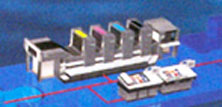Other CMMs only reference the CIELAB color space when performing the conversion from CMYK to CMYK. In this process, the four color channels are converted into three color channels, and the black channel information is lost. Imation's CFM not only calculates CMY information to ensure chroma matching, but also preserves black channel information in the image.
When the four-color ash is converted from CMYK to CMYK, the conventional CMM significantly changes the ratio between the basic color and the black ink. In an example, we use a conventional CMM to convert a CMYK=60 50 50 15 color from CMYK to CMYK in the same profile, and the result is CMYK=59 58 68 0 . However, doing the same conversion with Imation's CMM will keep the original ratio of CMYK=60 50 50 15 .

People who use CFM for the first time will notice that it is very slow compared to other CMMs because CFM performs a lot of calculations like a color management characterization program, generating a color lookup table to go from one color mode to the other Another color mode conversion. Color lookup tables are stored on the disk cache, and subsequent conversions are much faster.
Imation expects that the market for its CFM technology will be those users who must switch from one CMYK space to another, such as commercial printing to newspaper printing or vice versa. Dave Mayberry, Imation color fidelity program manager, said: "Many advertisements are produced for magazine printing (SWOP space) and can now be converted into newspaper printing (SNAP space) with a small amount of information lost."
Kodak CMM
Kodak's color matching method was developed by Eikonix in the early 1980s, and Kodak purchased the company in 1985. Eikonix was the first company to implement color management in a device-independent way. Kathy Stein, marketing strategy consultant at Kodak, said: "In the late 1980s, when we adopted the method of color management, other companies began to develop their own methods. The solutions are similar, but they are still self-reliant."
In the early 1990s, Kodak began discussions with Adobe, Apple, Sun, SGI, Agfa, and Microsoft on the definition of a universal format for device characterization data. Stein said: "We defined the structure of the description matrix and look-up table data in the CMM. These definitions became the ICC specification and also defined the behavior of the ICC-compliant CMM."
X-Rite CMM
X-Rite's CMM was originally developed by Ed Granger at Light Source Computer Images, a manufacturer of Colortron spectrophotometers, and uses a color model called AeQa. Light Source was acquired by X-Rite in 1997.
According to Dave Hazlett, general manager of the X-Rite Imaging Business Unit, X-Rite’s current strategy is to transfer its CMM technology licenses to other companies. X-Rite's CMM is implemented by HexWrench, which is developed by Studion and marketed by Pantone. HexWrench Six color separations for Pantone six-color printing technology.
Conclusion Our research shows that users can choose from a wide variety of CMMs for conversion from RGB to CMYK color modes without worrying about significant differences between different CMMs. High-end color splitters who require the best quality will use different CMMs to do experiments and make their own judgment on the color separation effect because slight, subjective differences in judgment do exist.
When converting from the CMYK color of one device to the CMYK color of another device, Imation CFM does have its advantages in maintaining the consistency of the black channel and in the resolution of CR, GCR, and black generation.
W Section Pales Palisade Fence
A Palisade Fence is a type of fence made up of vertical metal posts, called palisades, that are embedded into the ground. The palisades are typically pointed at the top to deter climbing or scaling. This type of fence is often used for security purposes, as it provides a strong physical barrier that is difficult to breach. Palisade fences are commonly seen around commercial properties, industrial sites, and high-security areas.
palisade fences are commonly used for residential, commercial, and industrial purposes due to their strength and ability to withstand harsh weather conditions.
W Section Pales Palisade Fence,Cast Iron Palisade Fence,Palisade Fencing,Palisade Fence
HEBEI DOUDOU METAL FENCE PRODUCTS CO.,LTD. , https://www.ddfencefencing.com